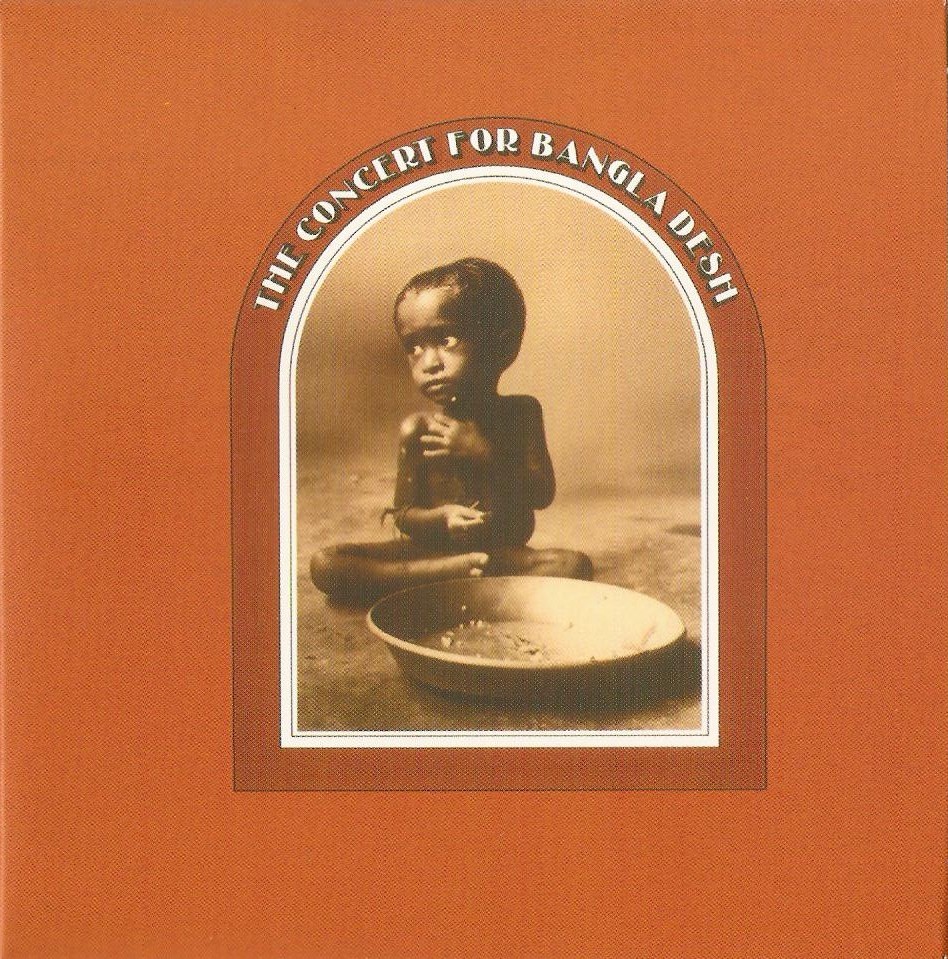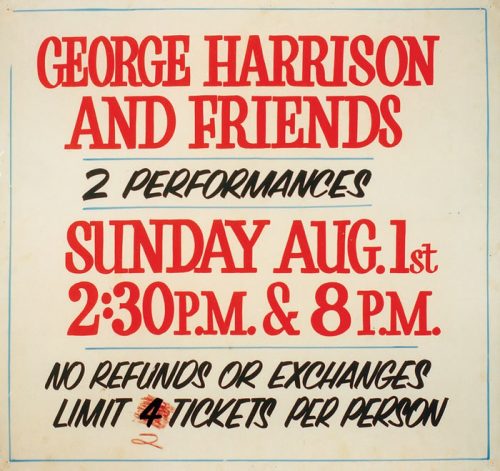
It started with a plea from one friend to another. George Harrison had been close to the legendary Indian classical musician Ravi Shankar since the mid-’60s, when the Beatle first sought an expert to teach him to play the multi-stringed Indian sitar. Shankar, older than Harrison by some 22 years and the acknowledged world master of the instrument, was from Bangladesh (previously known as East Pakistan) in the South Asian region of Bengal. At the time, in 1971, Harrison’s website states, “The country was ravaged by floods, famine and civil war, which left 10 million people—mostly women and children—fleeing their homes.” Feeling distraught and wanting to help, Shankar met with Harrison and asked if he might be able to draw attention to the crisis, and possibly use his fame to do something to raise some funds for aid. “Yes,” Harrison told him, “I think I’ll be able to do something.”

In April of 1971, Harrison went to work recruiting friends for a one-time-only concert; by June he had already received commitments from several of the biggest names on rock. He also arranged for a film and recording to be made of the event, the proceeds of which would go toward the cause. The concert date was set for August 1, 1971, two shows (afternoon and evening) to take place at New York’s Madison Square Garden. Not only would The Concert for Bangladesh be Harrison’s first major live appearance since the Beatles quit touring five years earlier, it would go down as one of the greatest evenings of classic rock in history.
The lineup was staggering: First, there was Ringo Starr. As if half of the Beatles wasn’t enough of an enticement to fans, Harrison brought in his good friend Eric Clapton, keyboardists Leon Russell and Billy Preston, bassist Klaus Voorman (an old friend from the Beatles’ Hamburg days), Jim Keltner doubling up with Ringo on drums, and a host of others.
The shows began with sets by Shankar and his musicians, followed by Harrison and his entourage, performing material both from his emerging solo career (“My Sweet Lord,” “Wah-Wah”) and the Beatles’ catalog (“While My Guitar Gently Weeps,” “Something”), as well as showcase tunes from Starr (“It Don’t Come Easy”), Russell and Preston.
Watch two performances from Starr and Preston
Watch Harrison, Ringo and Clapton perform “While My Guitar Gently Weeps” (Clip begins 17 seconds in…)
Harrison then brought the house down with “Here Comes the Sun,” his acoustic Beatles classic.
“We’re going to try one with just these acoustic guitars…”
But the moment that put the Concert for Bangladesh over the top as one for the ages was when Bob Dylan walked out onstage. Like Harrison, he had not performed in public much recently, since a 1966 motorcycle accident that caused him to reassess his life and career. Dylan, who was reportedly nervous about playing to such a large audience, arrived onstage for the first show accompanied by Harrison, Russell (on bass) and Starr (playing tambourine) and performed five of his greatest compositions: “A Hard Rain’s A-Gonna Fall,” “Blowin’ in the Wind,” “It Takes a Lot to Laugh, It Takes a Train to Cry,” “Love Minus Zero/No Limit” and “Just Like a Woman,” before Harrison and the band closed out the show.
Watch Dylan perform “A Hard Rain’s A-Gonna Fall”
The evening show followed a similar trajectory, with both Harrison and Dylan making a handful of changes to their set lists: Dylan, notably, added “Mr. Tambourine Man” in place of “Love Minus Zero.”
The Concert for Bangladesh recording, featuring highlights from the two shows, was released on December 20, 1971, and rose to #2 on the Billboard album chart, also winning the Grammy for Album of the Year. The film, released in the U.S. on March 23, 1972, was also a favorite among fans.
Watch Harrison and Russell sing lead on “Beware of Darkness,” with a cast of thousands
Related: Harrison and Shankar talk about the historic concerts
Following the Bangladesh concerts, some controversy ensued over the allocation of the funds but an estimated $12 million ultimately found its way to aid in the relief efforts over the next decade and a half. And in the world of rock music, the 1971 Concert for Bangladesh is viewed as a landmark event, the first true large-scale benefit concert of its type; it would serve as the model for Live Aid and is seen as the prototype for many other such charitable events even today.
Watch two remarkable clips via UPRestorations
As of August 2023, neither the album nor DVD was in print. And its 50th anniversary came and went without any news of a reissue.
If you’re a new Best Classic Bands reader, we’d be grateful if you would Like our Facebook page and/or bookmark our Home page.


14 Comments
I Would like to see this album reissued on 180 gram vinyl.
It may of been the 1st benefit concert but how many really know if it ?
All very noble … but what impact did the concerts have on poverty in Bangladesh?
Not much but luckily Bangladesh is no longer such a poor country….
“And a host of others” included the late, never mentioned, Jesse Ed Davis who spent a career in the back ground propping up others.
RIP Jesse.
Time now for full release of both concerts (unless the tapes don’t exist). Who wouldn’t want to hear these?
The LPs have some very short sides. Please release both concerts in their entirety.
Wow. I’d buy the album again just to get the “If Not for You” track. What else was left off?
Would love both concerts on CDs. And a Blu ray of both shows. Landmark concert.
Most people knew about it because, among the features artists, two Beatles were featured.
travelling fom upstate n.y. we missed ravi shankar and came in on the second song of the dylan set. i sat in the aisle steps and was completely overcome with joy.
I have always enjoyed George’s smile when he realizes the crowds admiration for “Here Comes the Sun.”
That’s exactly what I noticed and though how very human it response was even for someone as famous and well known as he was.
True enough, but it’s perhaps even more poignant to realize that he had never been the main focus before, and that maybe he (finally) belonged there. A great moment.